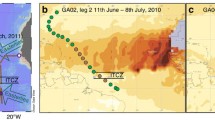Abstract
FLUXES of lead to the Great Lakes are dominated by atmospheric depositions of industrial lead, which account for ∼ 64% of the lead inputs to Lake Ontario and >90% of the inputs to Lake Superior1. It has recently been demonstrated that lead aerosols in the Great Lakes region may be identified by the contrasting 206Pb/207Pb ratios of industrial leads from the United States (1.221 ±0.009) and Canada (1.151 ±0.010)2. Here we show that those ratios may also be used to identify and trace industrial lead inputs to the Great Lakes. These corroborate spatial gradients in lead concentrations in surface waters, which range from 290 pmol kg−1 in Hamilton Harbour to <10 pmol kg−1 in the central waters of Lake Ontario. The latter concentrations and corresponding residence-time estimates, which are both an order of magnitude lower than previously reported, indicate that lead is rapidly scavenged in the epilimnion during periods of high primary productivity. We find that industrial lead from Canada and the United States are the two principal sources of lead contamination in the Great Lakes.
Similar content being viewed by others
References
Nriagu, J. O. in The Role of the Oceans as a Waste Disposal, 441–468 (Reidel, Dordrecht, 1986).
Sturges, W. T. & Barrie, L. A. Nature 329, 144–146 (1987).
Regal, A. R. & Patterson, C. C. Earth planet Sci. Lett. 64, 19–32 (1983).
Flegal, A. R. & Stukas, V. J. Mar. Chem. 22, 163–177 (1987).
Bruland, K. W., Coale, K. H. & Mart, L. Mar. Chem. 17, 285–300 (1985).
Coale, K. H. & Flegal, A. R. Sci. tot. Envir. (in the press).
Hudson, B. thesis, Washington Univ. (1981).
Lum, K. R., Kokotich, E. A. & Schroeder, W. H. Sci. tot. Envir. 63, 161–173 (1987).
Sigg, L. in Chemical Processes in Lakes (Wiley, New York, 1985).
Trefry, J. H., Metz, S., Troche, R. P. & Nelson, T. A. Science 230, 439–441 (1985).
Honeyman, B. D. & Santschi, P. Envir. Sci. Technol. 22, 862 (1988).
Munawar, M. & Munawar, I. F. Hydrobiologia 247, 181 (1986).
Boyle, E. A., Chapnick, S., Shen, G. T. & M. P. Bacon, M. P. J. geophys. Res. 91, 8573–8593 (1986).
Lead in the Canadian Environment: Science and Regulation, Final Report of the Commission of Lead in the Environment. Royal Society of Canada. Ottawa (1986).
Air Quality Criteria for Lead, U.S. Environmental Protection Agency, Triangle Park (1986).
Stukas, V. J. & Wong, C. S. Science 211, 1424–1427 (1981).
Flegal, A. R., Rosman, K. J. & Stephenson, M. R. Envir. Sci. Technol. 21, 1075–1079 (1987).
Schindler, D. W. Science 239, 149–157 (1988).
Maring, H., Settle, D. M., Buat-Menard, P., Dulac, F. & Patterson, C. C. Nature 330, 154–156 (1987).
Author information
Authors and Affiliations
Rights and permissions
About this article
Cite this article
Flegal, A., Nriagu, J., Niemeyer, S. et al. Isotopic tracers of lead contamination in the Great Lakes. Nature 339, 455–458 (1989). https://doi.org/10.1038/339455a0
Received:
Accepted:
Issue Date:
DOI: https://doi.org/10.1038/339455a0
- Springer Nature Limited
This article is cited by
-
Assessment of Airborne Lead Provenance in Northern Ontario, Canada, Using Isotopic Ratios in Snow and Cladonia rangiferina Lichens
Water, Air, & Soil Pollution (2021)
-
High-Precision (MC-ICPMS) Isotope Ratio Analysis Reveals Contrasting Sources of Elevated Blood Lead Levels of an Adult with Retained Bullet Fragments, and of His Child, in Milwaukee, Wisconsin
Biological Trace Element Research (2017)
-
Lead biogeochemistry in a central Ontario Forested watershed
Biogeochemistry (2007)
-
Using isotopic tracers in lake sediments to assess atmospheric transport of lead in Eastern Canada
Water, Air, and Soil Pollution (1996)
-
Anthropogenic lead in Antarctic sea water
Nature (1993)





